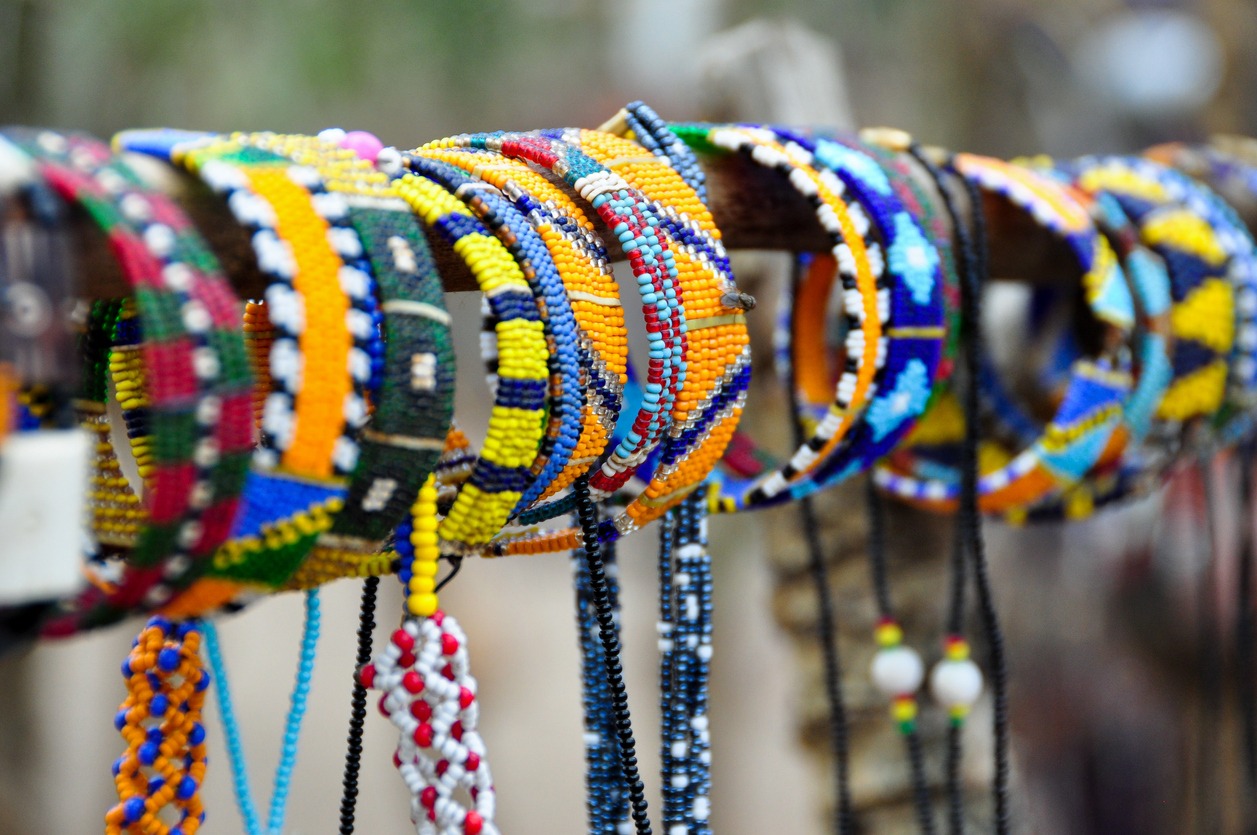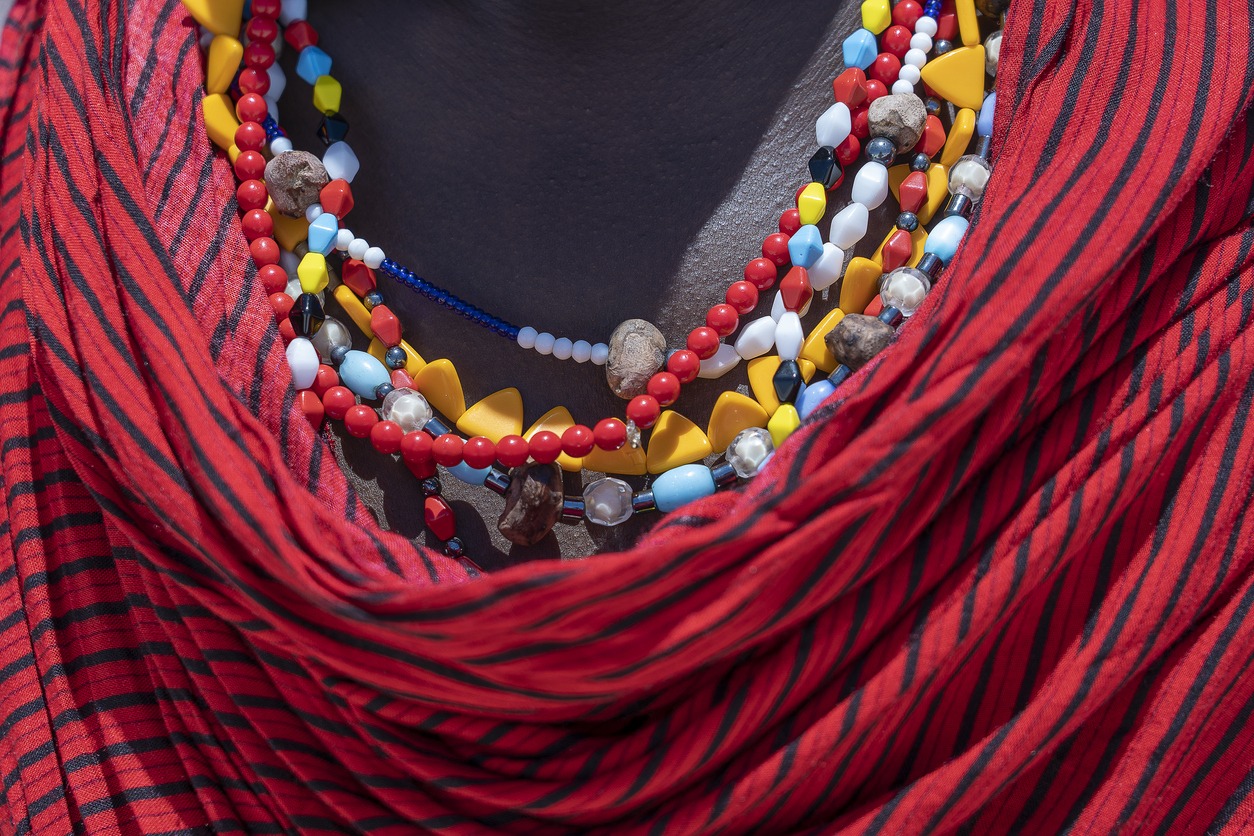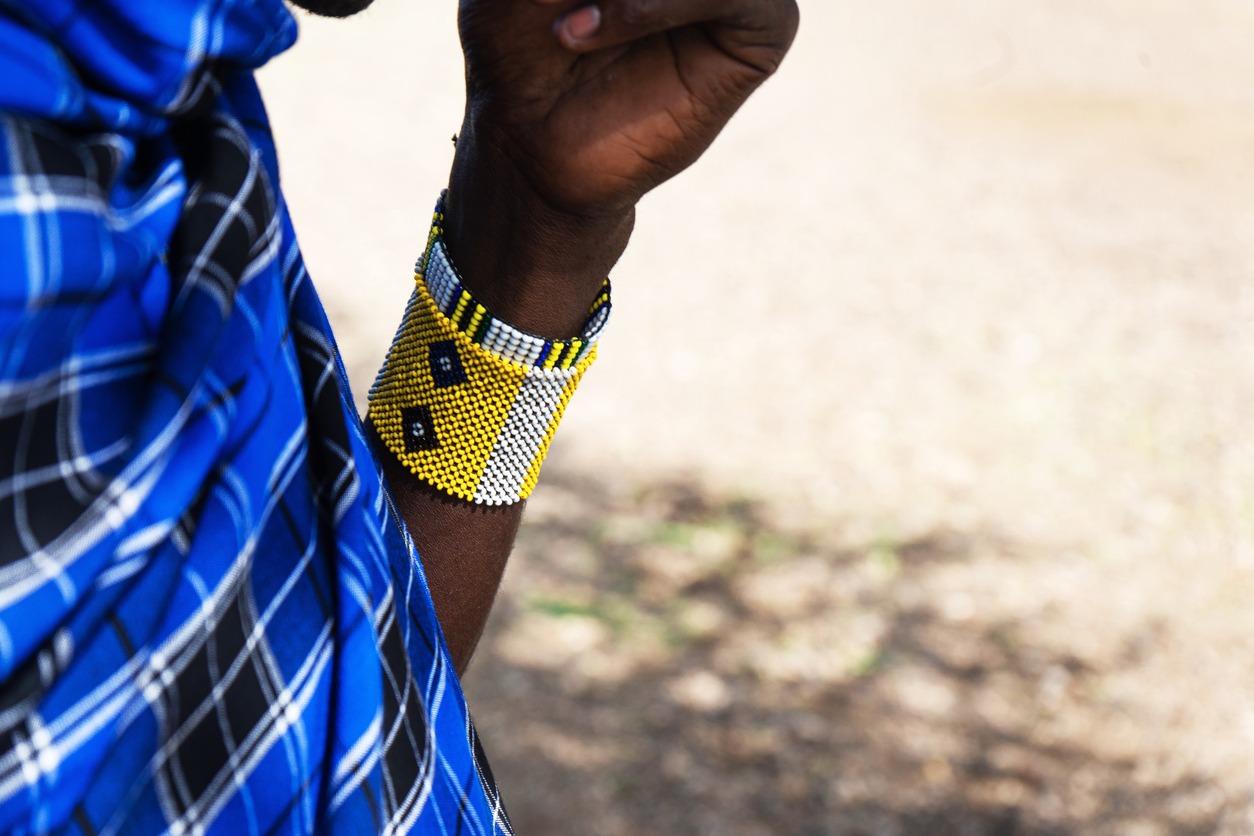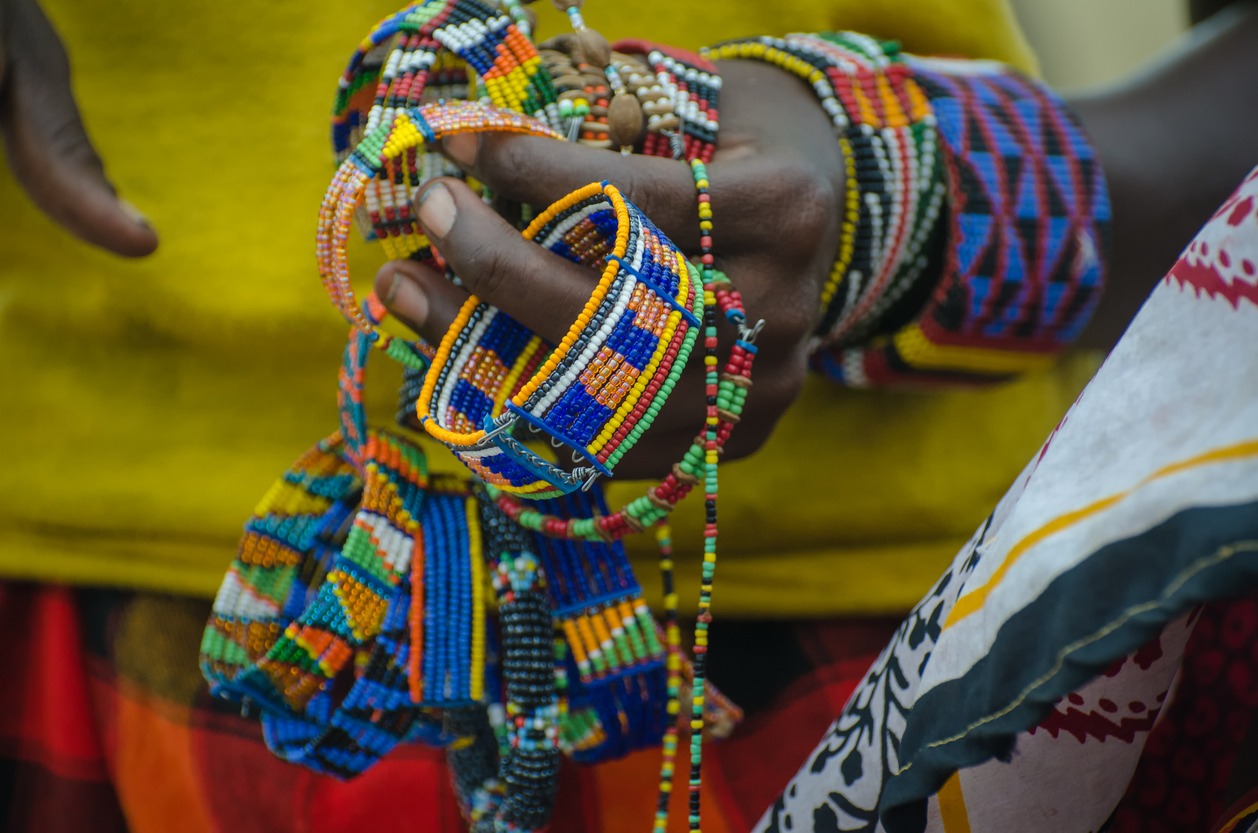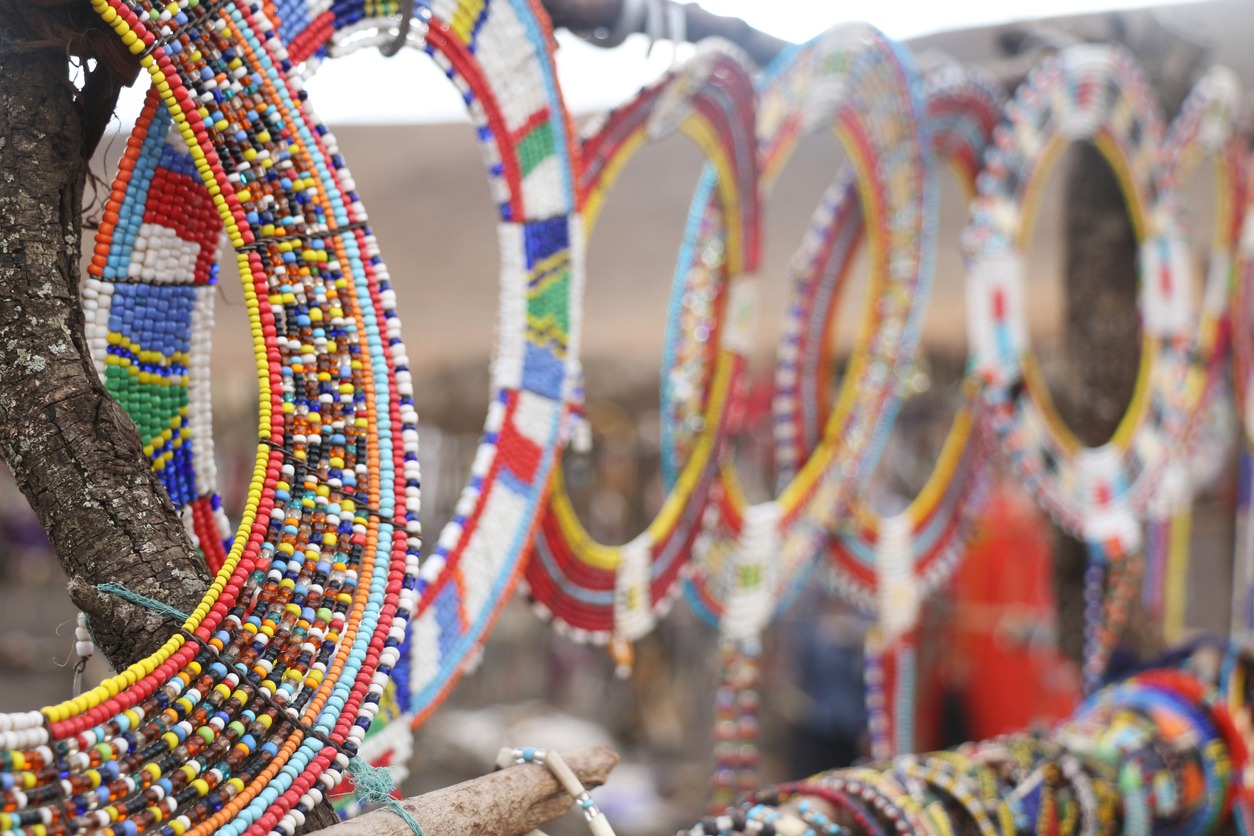The Maasai people, a distinct ethnic group residing primarily in Kenya and Tanzania, are renowned for their rich cultural traditions. Among these, beadwork stands out as a vibrant and intricate art form, deeply ingrained in their daily life and rituals. This craft, more than just an aesthetic expression, is a tapestry of colors and patterns that narrates stories, beliefs, and the heritage of the Maasai community.
In this article, we will learn about the meanings behind the colors and patterns in Maasai beadwork. While these decorative pieces are often admired for their striking beauty, each hue and design carries with it a deeper cultural significance. Understanding these elements not only enhances our appreciation of Maasai beadwork but also offers a glimpse into the values and history of the Maasai people themselves.
Historical Context of Maasai Beadwork
The roots of Maasai beadwork trace back several centuries, deeply embedded in the cultural fabric of the Maasai people. Originally, this craft was not centered around beads but utilized materials readily available in the environment. Early Maasai artisans crafted ornamental pieces from natural resources like seeds, wood, bones, and stones. These materials, while limited in variety, were skillfully used to create adornments that carried significant cultural value.
The Introduction of Glass Beads
The turning point in the history of Maasai beadwork came with the arrival of European traders in East Africa. In the late 19th and early 20th centuries, these traders introduced glass beads to the Maasai, which had an immense impact on their craft. Glass beads provided a broader spectrum of colors and allowed for greater durability and intricacy in designs. This shift not only enhanced the visual appeal of Maasai beadwork but also revolutionized the way in which the Maasai expressed their cultural identity.
Beadwork as a Cultural Record
With the advent of glass beads, Maasai beadwork evolved into a more dynamic and expressive art form. Each color and pattern began to hold more significant cultural meanings, often reflecting the social and environmental changes experienced by the Maasai. Beadwork became a living record, capturing the interactions between the Maasai and other cultures, their adaptation to colonial influences, and the shifts in their traditional lifestyle. It served as a historical document, preserving and passing down stories and customs through generations. In West Africa, there is another type of beadwork called Gusbi necklaces. Learn more about it by reading our article, How Do the Gusbi Necklaces of Western Africa Symbolize Status Through Beadwork?
Modern Adaptations
In contemporary times, while retaining its traditional essence, Maasai beadwork has adapted to the changing world. The art form has seen a blend of traditional and modern styles, catering to both the cultural preservation needs of the Maasai and the evolving tastes of a global audience. This adaptation has ensured that the beadwork remains a relevant and vibrant expression of Maasai heritage, even as the community navigates the challenges of the modern world.
From its humble beginnings with natural materials to its vibrant presence with glass beads, it stands as a testament to the resilience and adaptability of Maasai culture.
Significance of Colors in Maasai Beadwork
In the realm of Maasai beadwork, colors are not merely decorative; they are imbued with deep symbolic meanings. Each hue used in their intricate designs holds a specific significance, rooted in the Maasai’s relationship with the natural world, their social structure, and spiritual beliefs. Understanding these colors is essential to appreciating the depth of Maasai’s beadwork and the stories it tells.
Key Colors and Their Meanings
- Red: Symbolizes bravery, strength, and unity. Often associated with the Maasai warriors, reflecting their courage and bloodshed in defense of the community.
- Blue: Represents energy and the sky. This signifies the importance of rainfall for their pastoral lifestyle.
- Green: Symbolizes health and land. Reflects the Maasai’s deep connection and dependence on the earth and its resources.
- Yellow: Stands for fertility and growth. Often associated with the sun, which is crucial for sustaining life.
- Orange: Symbolizes hospitality and generosity. Reflects the warm, welcoming nature of the Maasai culture.
- White: Represents purity and health. Also signifies peace and is often worn during times of truce and harmony.
- Black: Symbolizes unity and solidarity. Often associated with the people and the struggles they endure.
The Interplay of Colors
The Maasai don’t just use these colors individually; they often combine them in intricate patterns, each combination telling a different story or conveying a specific message. For example, a mix of red and white can symbolize the unity of warriors and the peace they protect. The way these colors interact within beadwork patterns reflects the complexity of Maasai beliefs and their dynamic cultural narrative.
Contemporary Interpretations
While traditional meanings are still prevalent, contemporary Maasai beadwork sometimes incorporates new colors due to the availability of modern dyes and changing cultural dynamics. These new colors are often integrated into traditional designs, creating a fusion that respects historical significance while embracing modernity.
The colors in Maasai beadwork are a vibrant language of their own, communicating values, beliefs, and the history of the Maasai people. They are an integral part of Maasai identity, weaving a colorful tapestry that links the past with the present.
Patterns and Designs in Maasai Beadwork
The patterns and designs in Maasai beadwork are as significant as the colors used. These intricate designs are more than just aesthetic embellishments; they serve as a visual language that communicates identity, social status, and cultural narratives. Each pattern holds a special meaning and is carefully crafted to convey specific messages within the Maasai community.
Common Patterns and Their Meanings
- Geometric Shapes: Circles, triangles, and squares are prevalent, each with its own symbolism. Circles often represent the continuity of life and community. Triangles can symbolize the dual nature of life; for instance, two triangles joined base-to-base represent the journey from birth to death and back to birth.
- Lines and Stripes: Straight lines can symbolize paths or journeys. Stripes are often used to denote different social statuses or age groups within the community.
- Repetitive Sequences: Repetitive patterns can signify social responsibilities or rites of passage. The repetition can also symbolize the Maasai’s connection to their ancestors and the continuity of their traditions.
Designs Signifying Identity and Status
- Age-Specific Patterns: Certain designs are specific to different age groups, like the intricate beadwork worn by warriors or the more subdued styles of elders.
- Gender-Specific Designs: Men and women wear distinct patterns that reflect their roles and status within the community. Women’s beadwork often includes symbols representing fertility and the family.
- Marital Status Indicators: Married women wear specific patterns that are different from those worn by single women, indicating their marital status within the community.
Regional Variations
While there is a shared language of patterns and designs, different Maasai sub-groups have variations unique to their region. These variations allow the Maasai to identify each other’s regional origins and sometimes even clan affiliations.
Modern Influences
In recent times, Maasai beadwork has seen influences from external cultures and the global fashion industry. While traditional patterns are still predominant, new designs have emerged, blending contemporary aesthetics with cultural significance.
The patterns and designs in Maasai beadwork are a complex tapestry of symbols that communicate a wide range of cultural, social, and personal messages. They are an integral part of Maasai identity, offering a vivid glimpse into their rich cultural landscape and serving as a medium for preserving and sharing their heritage.
Beadwork in Maasai Ceremonies and Everyday Life
In the Maasai culture, ceremonies are pivotal events, and beadwork plays a crucial role in these occasions. Each ceremony, from births and weddings to rites of passage and warrior initiations, is accompanied by specific beadwork that holds significant meaning.
- Weddings and Engagements: During weddings, brides and grooms wear elaborate beadwork, each piece symbolizing their new status and responsibilities. Bridal beadwork, often in bright colors, symbolizes beauty, health, and fertility.
- Initiation Rites: Beadwork is integral to initiation ceremonies for both young men and women. The transition from childhood to adulthood is marked with special beadwork designs that signify their new social status.
- Ceremonial Attire: Specific patterns and colors are used in ceremonies to represent the community’s blessings and hope for individuals undergoing these life transitions.
Apart from ceremonial use, beadwork is a prominent feature in the everyday life of the Maasai. It’s not just a decorative item but a symbol of identity and social status.
- Daily Wear: Men and women incorporate beadwork into their daily attire, reflecting their age, social status, and marital status.
- Symbol of Pride and Identity: Wearing beadwork is a matter of pride and a way to showcase one’s heritage and identity. It is a visible connection to Maasai traditions and values.
- Gifts and Exchanges: Beadwork items are often given as gifts, serving as a means of strengthening social bonds and expressing respect and appreciation.
The process of making beadwork is a skill passed down through generations. It’s often a communal activity where knowledge and stories are shared along with the craft. Creating beadwork requires precision and skill. The patterns are meticulously planned and executed, often taking days to complete. The act of beadwork creation is also a time for the older generation to impart wisdom, stories, and cultural values to the younger members.
In the modern context, Maasai beadwork has adapted to changing times while retaining its cultural essence. Maasai beadwork has found its way into the global fashion industry, with designers collaborating with Maasai artisans to create contemporary pieces. Despite these modern influences, the Maasai have strived to preserve the traditional aspects of their beadwork, ensuring that their cultural heritage continues to thrive.
Contemporary Influences and Changes
The Maasai community, while deeply rooted in tradition, has not remained isolated from the globalizing world. Contemporary influences have seeped into their culture, and beadwork is no exception. This intersection of tradition and modernity has led to notable changes in the styles, materials, and meanings of Maasai beadwork.
Influence of Tourism and the Global Market
The growth of tourism in Kenya and Tanzania has significantly impacted Maasai beadwork. Artisans often create pieces that cater to the tastes and preferences of tourists, which has introduced new styles and patterns in their beadwork. Access to the global market through online platforms and international trade has widened the exposure of Maasai beadwork. This has encouraged artisans to experiment with new designs that appeal to a broader audience while still retaining traditional elements.
Shifts in Material Use and Techniques
With the availability of new materials, Maasai artisans have started incorporating modern beads and synthetic materials, which offer a wider variety of colors and greater durability. The beadwork techniques have also evolved, with artisans adopting new methods to increase efficiency and cater to large-scale production demands.
Changes in Cultural Significance
While traditional symbolic meanings of colors and patterns are still respected, there has been a gradual shift towards more abstract and aesthetic-driven designs in beadwork. Younger Maasai generations, influenced by global trends and education, are bringing new perspectives to beadwork, blending traditional motifs with contemporary designs.
Preservation and Innovation
The Maasai community faces the challenge of balancing the preservation of their traditional beadwork heritage with the need to adapt to modern economic and social landscapes. Efforts are being made to educate younger generations about the traditional meanings and techniques of beadwork, ensuring that these cultural elements are not lost.
Ethical Considerations
With the commercialization of Maasai beadwork, ethical concerns such as fair compensation for artisans and accurate representation of their culture in the global market have become increasingly important.
The contemporary influences on Maasai beadwork reflect a dynamic culture that is adapting to the challenges and opportunities of a globalized world. While embracing change, the Maasai community is also striving to preserve the core elements of their beadwork tradition, ensuring that this vibrant art form continues to be a meaningful expression of their heritage.
Conclusion
Maasai beadwork is a vivid reflection of a culture that is both deeply traditional and dynamically evolving. Through the colors, patterns, and designs of their beadwork, the Maasai continue to express their identity, social values, and heritage. Despite the influences of modernization and globalization, this art form has maintained its cultural significance, adapting to new challenges while preserving its traditional essence. As it bridges the past with the present, Maasai beadwork remains a compelling testament to the resilience and adaptability of this unique community.
